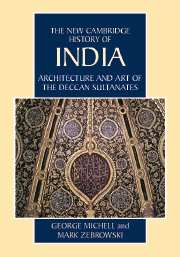Book contents
- Frontmatter
- Introduction
- 1 Historical framework
- 2 Forts and palaces
- 3 Mosques and tombs
- 4 Architectural decoration
- 5 Miniature painting: Ahmadnagar and Bijapur
- 6 Miniature painting: Golconda and other centres
- 7 Textiles, metalwork and stone objects
- 8 Temples
- 9 Conclusion
- Appendix: Dynastic Lists of Deccan Rulers
- Bibliographic Essay
- Bibliography
- Index
- Map of the Southern Deccan"
- Plate Section"
7 - Textiles, metalwork and stone objects
Published online by Cambridge University Press: 28 March 2008
- Frontmatter
- Introduction
- 1 Historical framework
- 2 Forts and palaces
- 3 Mosques and tombs
- 4 Architectural decoration
- 5 Miniature painting: Ahmadnagar and Bijapur
- 6 Miniature painting: Golconda and other centres
- 7 Textiles, metalwork and stone objects
- 8 Temples
- 9 Conclusion
- Appendix: Dynastic Lists of Deccan Rulers
- Bibliographic Essay
- Bibliography
- Index
- Map of the Southern Deccan"
- Plate Section"
Summary
painted cottons
Amongst the Asian products which most stirred the admiration and envy of Europe in the seventeenth and eighteenth centuries were Chinese porcelains and Indian painted cottons commonly called ‘chintzes’ in English-speaking countries. Compared with European linens and woollens, Indian painted and dyed cottons seemed almost miraculous: they were light and comfortable, they could be easily washed and – most surprisingly – their rich colours were fast. The complicated and time-consuming technology involved in the manufacture of these textiles was the result of centuries, perhaps millennia, of secret knowledge gradually amassed, refined and passed on from father to son. Cotton on its own will not accept permanent dyeing; what Indian craftsmen had discovered was the use of mordants (metallic salts which combine with various dyes and permit them to bond with cotton fibres) in conjunction with resists (materials used to prevent colouring particular areas of the cloth), the process permitting lively detailed patterning and brilliant colours.
Several factors suggest that the best painted cottons were produced on the Bay of Bengal (Coromandel) coast of the kingdom of Golconda. First, the vibrant tone of red most prized in Europe was produced by the root of the chay plant when grown in the calcium-rich soil of the Krishna river delta. Second, craftsmen on this coast tended to use a pen and brush to apply colour, giving a much freer design than could be achieved with blocks, which were more commonly used in western India. Thirdly, the human figures resemble – and are occasionally identical to – known Golconda paintings on paper, and certain motifs are present in other classes of Deccani decorative arts.
- Type
- Chapter
- Information
- Architecture and Art of the Deccan Sultanates , pp. 226 - 245Publisher: Cambridge University PressPrint publication year: 1999

